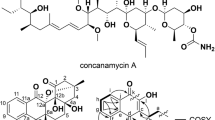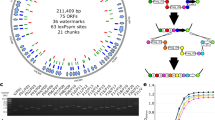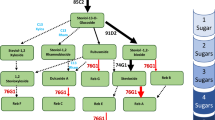Abstract
The molecular cloning and characterization of the gene encoding exo–cellobiohydrolase I (CBHI) of Trichoderma reesei strain L27 is reported. Two adjacent HindIII genomic fragments of 1.16 kb and 2.3 kb were identified using differential hybridization techniques and were sub–cloned into plasmid pBR322. The identification of the gene encoding CBHI was determined by hybrid selection and confirmed by DNA sequence analysis. There are two introns in the genomic DNA that were identified by comparing the coding sequence with the published amino acid sequence1 and confirmed by sequencing of cDNA clones. Both introns were found to contain a 10 bp sequence, CAGCT–GACTG, that is homologous to a sequence necessary for splicing of introns in yeast2.
This is a preview of subscription content, access via your institution
Access options
Subscribe to this journal
Receive 12 print issues and online access
$209.00 per year
only $17.42 per issue
Buy this article
- Purchase on Springer Link
- Instant access to full article PDF
Prices may be subject to local taxes which are calculated during checkout
Similar content being viewed by others
References
Fagerstam, L.G. 1981. Cellulases from Trichoderma reesei QM9414: Enzymatic and structural properties. Doctoral Thesis, University of Uppsala, Sweden.
Langford, C.J. and Gallwitz, D. 1983. Evidence for an intron-contained sequence required for the splicing of yeast polymerase II transcripts. Cell 33: 519–527.
Shoemaker, S.P., Watt, K., Tsitovsky, G. and Cox, R.V. 1983. Characterization and properties of cellulases purified from Trichoderma reesei strain L27. BIO/TECHNOLOGY 1: 687–690.
Shoemaker, S.P. and Brown, R.D. Jr., 1978. Characterization of endo-1,4-β-D-glucanase purified from Trichoderma viride. Biochim. Biophys. Acta 523: 147–161.
White, A.R. 1981. Visual characterization of the mode of action of the cellulase enzyme system of the fungus Trichoderma reesei. Ph. D. Thesis. University of North Carolina, Chapel Hill, NC.
Wood, T.M. 1982. Enzymic and other factors affecting microbial generation of soluble sugars from cellulosic materials, p. 327–334. In: Proceedings of 1982 Research and Development Division Conference. TAPPI: Ashville, NC.
Whittle, D.J., Kilburn, D.G., Warren, R.A.J., Miller, R.C. Jr., 1982. Molecular cloning of a Cellulomonas fimi cellulase gene in Escherichia coli. Gene 17: 139–145.
Cornet, P., Tronik, D., Millet, J. and Aubert, J. 1983. Cloning and expression in Escherichia coli of Clostridium thermocellum genes coding for amino acid synthesis and cellulose hydrolysis. FEMS Lett. 16: 137–141.
Cornet, P., Millet, J., Beguin, P., Aubert, J. 1983. Characterization of two cel (cellulose degradation) genes of Clostridium thermocellum coding for endoglucanases. BIO/TECHNOLOGY 1: 589–594.
Wilson, D.B. and Collmer, A. 1983. Cloning and Expression of a Thermomonospora YX endocellulase gene in E. coli BIO/TECHNOLOGY 1: 594–601.
Shoemaker, S.P., Raymond, J.C., Bruner, R. 1981. Cellulases: Diversity amongst improved Trichoderma strains, p. 89–109. In: Trends in the Biology of Fermentations for Fuels and Chemicals. A. Hollaender et al. (eds.) Plenum Publishing Co., New York.
Mount, S.M. 1982. A catalogue of splice junction sequences. Nucleic Acids Res. 10: 459–472.
Dobson, M.J., Tuite, M.F., Roberts, N.A., Kingsman, A.J. and Kingsman, S.M. 1982. Conservation of high efficiency promoter sequences in Saccharomyces cerevisiae. Nucleic Acids Res. 10: 2625–2637.
Chen, H.R., Dayhoff, M.O., Barker, W.C., Hunt, L.T., Yeh, L.-S., George, D.G., Orcutt, B.C. 1982. Nucleic acid sequence database IV. DNA 1: 365–374.
Holland, J.P. and Holland, M.J. 1979. The primary structure of a glyceraldehyde-3-phosphate dehydrogenase gene from Saccharomyces cerevisiae. J. Biol. Chem. 254: 9839–9845.
Holland, M.J., Holland, J.P., Thill, G.P., Jackson, A.J. 1981. The primary structures of two yeast enolase genes. J. Biol. Chem. 256: 1385–1395.
Chirgwin, J.M., Przybyla, A.E., MacDonald, R.J. and Rutter, W.J. 1979. Isolation of biologically active ribonucleic acid from sources enriched in ribonuclease. Biochem. J. 18: 5294–5299.
O'Farrell, P.H. 1975. High resolution two-dimensional electrophoresis of proteins. J. Biol. Chem. 250: 4007–4021.
Bailey, J.M. and Davidson, N. 1976. Methylmercury as a reversible denaturing agent for agarose gel electrophoresis. Anal. Biochem. 70: 75–85.
Seghal, P.B. and Sagar, A.D. 1980. Heterogeneity of poly(I) · poly (C)-induced fibroblast interferon mRNA species. Nature 288: 95–97.
Loenen, W.A. and Brammar, W.J. 1980. A bacteriophage lambda vector for cloning large DNA fragments made with several restriction enzymes. Gene 10: 249–259.
Koths, K. and Dressler, D. 1980. The rolling circle-capsid complex as an intermediate in OX DNA replication and viral assembly. J. Biol. Chem. 255: 4328–4338.
Hohn, B. 1979. In vitro packaging of λ and cosmid DNA, p. 299–309. In: Methods in Enzymology, vol. 68. R. Wu (ed.) Academic Press, New York.
Maniatis, T., Fritsch, E.F. and Sambrook, J. 1982. Molecular cloning: A laboratory manual. Cold Spring Harbor Laboratory, Cold Spring Harbor, New York.
Meselson, M. and Yuan, R. 1968. DNA restriction enzyme from E. coli. Nature 217: 1110–1114.
Clarke, L. and Carbon, J. 1976. A colony bank containing synthetic ColEl hybrid plasmids representative of the entire E. coli genome. Cell 9: 91–102.
Benton, W.D. and Davis, R.W. 1977. Screening λgt recombinant clones by hybridization to single plaques in situ. Science 196: 180–182.
Harpold, M.M., Dobner, P.R., Evans, R.M., Bancroft, F.C. 1978. Construction and identification by positive hybridization-translation of a bacterial plasmid containing a rat growth hormone structural gene sequence. Nucleic Acids Res. 5: 2039–2053.
Sanger, F., Nicklen, S. and Coulsen, A.R. 1977. DNA sequencing with chain terminating inhibitors. Proc. Natl. Acad. Sci. USA 74: 5463–5467.
Messing, J., Crea, R. and Seeburg, P.H. 1981. A system for shotgun DNA sequencing. Nucleic Acids Res. 9: 309–321.
Maxam, A.M. and Gilbert, W. 1977. A new method for sequencing DNA. Proc. Natl. Acad. Sci. USA 74: 560–564.
Author information
Authors and Affiliations
Rights and permissions
About this article
Cite this article
Shoemaker, S., Schweickart, V., Ladner, M. et al. Molecular Cloning of Exo–Cellobiohydrolase I Derived from Trichoderma Reesei Strain L27. Nat Biotechnol 1, 691–696 (1983). https://doi.org/10.1038/nbt1083-691
Received:
Accepted:
Issue Date:
DOI: https://doi.org/10.1038/nbt1083-691
This article is cited by
-
Genetic engineering and raising temperature enhance recombinant protein production with the cdna1 promoter in Trichoderma reesei
Bioresources and Bioprocessing (2022)
-
Engineering of the Trichoderma reesei xylanase3 promoter for efficient enzyme expression
Applied Microbiology and Biotechnology (2018)
-
Cellulases and beyond: the first 70 years of the enzyme producer Trichoderma reesei
Microbial Cell Factories (2016)



